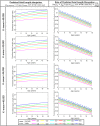A machine learning-based algorithm used to estimate the physiological elongation of ocular axial length in myopic children
- PMID: 33102610
- PMCID: PMC7579939
- DOI: 10.1186/s40662-020-00214-2
A machine learning-based algorithm used to estimate the physiological elongation of ocular axial length in myopic children
Abstract
Background: Axial myopia is the most common type of myopia. However, due to the high incidence of myopia in Chinese children, few studies estimating the physiological elongation of the ocular axial length (AL), which does not cause myopia progression and differs from the non-physiological elongation of AL, have been conducted. The purpose of our study was to construct a machine learning (ML)-based model for estimating the physiological elongation of AL in a sample of Chinese school-aged myopic children.
Methods: In total, 1011 myopic children aged 6 to 18 years participated in this study. Cross-sectional datasets were used to optimize the ML algorithms. The input variables included age, sex, central corneal thickness (CCT), spherical equivalent refractive error (SER), mean K reading (K-mean), and white-to-white corneal diameter (WTW). The output variable was AL. A 5-fold cross-validation scheme was used to randomly divide all data into 5 groups, including 4 groups used as training data and one group used as validation data. Six types of ML algorithms were implemented in our models. The best-performing algorithm was applied to predict AL, and estimates of the physiological elongation of AL were obtained as the partial derivatives of AL predicted -age curves based on an unchanged SER value with increasing age.
Results: Among the six algorithms, the robust linear regression model was the best model for predicting AL, with a R 2 value of 0.87 and relatively minimal averaged errors between the predicted AL and true AL. Based on the partial derivatives of the AL predicted -age curves, the estimated physiological AL elongation varied from 0.010 to 0.116 mm/year in male subjects and 0.003 to 0.110 mm/year in female subjects and was influenced by age, SER and K-mean. According to the model, the physiological elongation of AL linearly decreased with increasing age and was negatively correlated with the SER and the K-mean.
Conclusions: The physiological elongation of the AL is rarely recorded in clinical data in China. In cases of unavailable clinical data, an ML algorithm could provide practitioners a reasonable model that can be used to estimate the physiological elongation of AL, which is especially useful when monitoring myopia progression in orthokeratology lens wearers.
Keywords: Machine learning; Myopia; Myopia progression; Ocular axial length; Orthokeratology; Physiological elongation.
© The Author(s) 2020.
Conflict of interest statement
Competing interestsThe authors have no competing interests to report.
Figures




Similar articles
-
Effect of orthokeratology on axial length elongation in moderate myopic and fellow high myopic eyes of children.Clin Exp Optom. 2021 Jan;104(1):22-27. doi: 10.1111/cxo.13067. Clin Exp Optom. 2021. PMID: 32266747
-
Factors associated with faster axial elongation after orthokeratology treatment.BMC Ophthalmol. 2022 Feb 8;22(1):62. doi: 10.1186/s12886-022-02294-1. BMC Ophthalmol. 2022. PMID: 35135507 Free PMC article.
-
Central and Peripheral Corneal Power Change in Myopic Orthokeratology and Its Relationship With 2-Year Axial Length Change.Invest Ophthalmol Vis Sci. 2015 Jul;56(8):4514-9. doi: 10.1167/iovs.14-13935. Invest Ophthalmol Vis Sci. 2015. PMID: 26200489
-
Effects of orthokeratology lens on axial length elongation in unilateral myopia and bilateral myopia with anisometropia children.Cont Lens Anterior Eye. 2020 Feb;43(1):73-77. doi: 10.1016/j.clae.2019.12.001. Epub 2019 Dec 17. Cont Lens Anterior Eye. 2020. PMID: 31862203
-
Efficacy, Safety and Acceptability of Orthokeratology on Slowing Axial Elongation in Myopic Children by Meta-Analysis.Curr Eye Res. 2016 May;41(5):600-8. doi: 10.3109/02713683.2015.1050743. Epub 2015 Aug 3. Curr Eye Res. 2016. PMID: 26237276 Review.
Cited by
-
Machine Learning-Based Integration of Metabolomics Characterisation Predicts Progression of Myopic Retinopathy in Children and Adolescents.Metabolites. 2023 Feb 17;13(2):301. doi: 10.3390/metabo13020301. Metabolites. 2023. PMID: 36837920 Free PMC article.
-
Panretinal Optical Coherence Tomography.IEEE Trans Med Imaging. 2023 Nov;42(11):3219-3228. doi: 10.1109/TMI.2023.3278269. Epub 2023 Oct 27. IEEE Trans Med Imaging. 2023. PMID: 37216244 Free PMC article.
-
Machine-learning models to predict myopia in children and adolescents.Front Med (Lausanne). 2024 Nov 19;11:1482788. doi: 10.3389/fmed.2024.1482788. eCollection 2024. Front Med (Lausanne). 2024. PMID: 39629228 Free PMC article.
-
Effect of 0.02% and 0.01% atropine on ocular biometrics: A two-year clinical trial.Front Pediatr. 2023 Jan 17;11:1095495. doi: 10.3389/fped.2023.1095495. eCollection 2023. Front Pediatr. 2023. PMID: 36733432 Free PMC article.
-
Development of Refractive Parameters in 3- to 6-Year-Old Children and Its Application in Myopia Prediction and Intervention Guidance.Comput Math Methods Med. 2021 Dec 16;2021:3656831. doi: 10.1155/2021/3656831. eCollection 2021. Comput Math Methods Med. 2021. Retraction in: Comput Math Methods Med. 2023 Nov 1;2023:9801927. doi: 10.1155/2023/9801927. PMID: 34956396 Free PMC article. Retracted.
References
LinkOut - more resources
Full Text Sources

